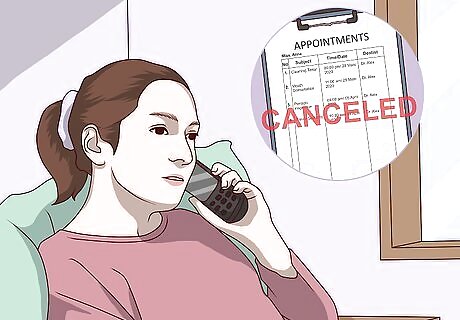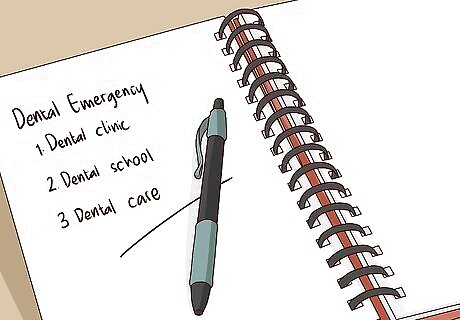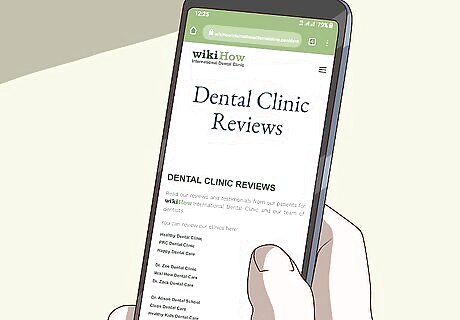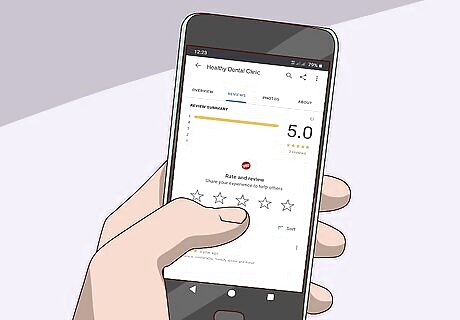
views
Leaving Your Current Dentist

Determine if you should leave your dentist. Most people choose to change dentists if they move away from their current dentist. You might also decide to leave if you don't feel comfortable at the practice, the treatments are too expensive, or you think the dentist's office isn't clean or up-to-date. You should feel comfortable and listened to by your dentist. If you feel like they're dismissive or don't reassure, consider changing dentists.

Contact your current dentist to cancel your appointments. Let the office know that you'd like to cancel all future appointments with the dentist. They may ask you why you're leaving their practice, and it's fine to be honest with them about why you're changing dentists. If you feel uncomfortable talking with the office, email them or ask your new dentist's office to contact them.

Gather your dental records. You have a legal right to your dental records so contact your current dentist and tell them that you'd like a copy of your records. Keep in mind that the dentist will keep the original records and will provide you with a paper or electronic copy.Tip: Ask the office if you'll be charged for the records. Some practices charge a small fee to print and mail the records to you.

Contact your insurance company tell them you'd like to switch dentists. Since insurance companies have different procedures, call yours and let them know you want to leave your dentist. They may give you a list of dentists that they cover or they'll tell you to find a practice that's accepting patients before you inform the insurance company. This is especially important if you've been assigned a dentist by your insurance company.

Plan for a dental emergency if you don't have a dentist yet. If there will be a gap in your dental coverage, create a backup plan for a dental emergency. Look for dental schools or public dental clinics that offer services for a reduced fee. Some communities even offer free dental clinics. Write down a few of these options so you know who to contact in a dental emergency.
Selecting a New Dentist

Ask family and friends for recommendations. Let your social network know that you're looking for dentist recommendations. If you do get recommendations, ask your family and friends why they like the dentist, how easy it is to schedule appointments, and how long appointments usually take. If you know you'll need a specific procedure, such as a root canal, ask your friends if they can recommend dentists that are good with the procedure.

Check which dentists are covered by your insurance. If you have dental insurance, call your insurance provider or get on their website to look for dental practices that are in your coverage network. Make a list of these providers so you can begin researching them. If you don't have dental insurance, talk with potential dentists to learn the cost of basic procedures.

Gather information about dentists from review sites. Check review sites that provide feedback and ratings on local dentists and their practices. Read through patient reviews to learn what people think about the dentist and whether or not they recommend the dentist. You should also find out if any of the dentists are endorsed by local schools of dentistry.

Read reviews of potential dentists. Go online and search for reviews of each potential dentist and their office. Pay attention to what their current patients think about the practice and whether or not they recommend the dentist. Pay attention to how many people have contributed reviews. Be wary about forming opinions based on only a couple of reviewers.

Call potential dentists and ask if they're accepting new patients. If a dentist already has too many patients, they might not take you as a patient. When you call the office you should also double-check that they take your insurance.Tip: If the practice isn't accepting new patients, they may ask if you'd like to be put on a waiting list for when space opens up.

Check out the new practice in person. Call the new office and ask them any questions you have about the practice. You can also ask to come by for a quick tour of their facilities. Pay attention to how clean the practice is and how comfortable you feel. The office should make you feel welcome, even if they can't let you tour the practice. If you feel like the office treated you rudely, check another practice.
Making a Smooth Transition

Schedule an appointment with the new dentist. Call the office and give them your insurance information. Let them know you'd like to schedule your first appointment with the dentist and be sure to tell them about any procedures you're in the middle of receiving. For example, tell them if you had any surgeries planned with your previous dentist or if you're interested in future dental work.

Request a records transfer. Ask the new dentist if they'll contact your previous dentist or if you need to call them. You'll probably need to sign a release form for the previous dentist so they can send your records to your new dentist.Tip: Some dental practices charge a fee to transfer or mail the records so ask when you call.

Ask your new dentist if you need new X-rays. New patients usually need to get X-rays so the dentist can get up-to-date information on your gums, bone structure, and teeth. Keep in mind that this means your first appointment will probably be a little longer than following appointments. The dentist should also talk with you about your dental history and any fears or anxieties you have about visiting the dentist.

Bring paperwork to your first appointment and discuss your treatment goals. You'll probably be asked to bring your insurance information and fill out patient forms. The office needs your contact information and medical history. Be prepared to spend time at the first meeting talking about your treatment goals and concerns. For example, you might tell the new dentist that you've been putting off getting fillings and know that you'll need them.

















Comments
0 comment